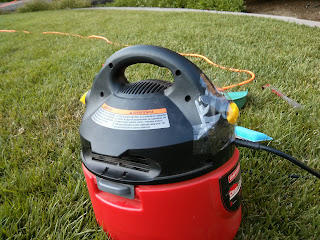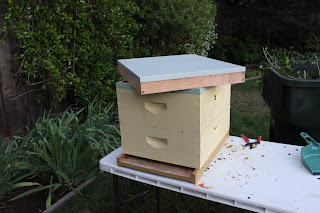Attempt 1: Leave the hive near the site of the wild hive so that the bees in the old location can smell the bees in the new location. In hind site, I should have left the hive close to the wild hive site a little longer, I only left the hive near the old location for 18 hours. I've heard that the bees could take up to 2 days to relocate.
Here is what the bees looked like on Thursday afternoon, the day after we removed the hive from the fence and after my "attempt 1" at picking up the stragglers:
There was also a small cluster on the ground:
Attempt 2: brush the bees off the fence to try to clean away residual wax. The wax holds the smell that the bees are attracted to, by removing it, the bees may just leave. I think the "brushing" part of this attempt really only riled the bees up and didn't really encourage them to leave at all. I wasn't able to clean too much wax off of the fence either.
Attempt 3: Cover the area of the fence with the wax until the bees leave, then clean the wax off. I don't think my covering was properly attached to the fence, so the bees wiggled underneath.
Four days after the initial removal of the hive from the fence, the number of stragglers didn't seem to dwindle too much. If anything, they sort of just moved upwards into the vine plant, the bees on the ground also remained:
Attempt 4: Homemade bee vacuum! Okay, there is such thing as a vacuum that you use on bees. It's expensive. There are a bunch of forums that show you how to make your own out of a shop vac. Here is my attempt using a 2 gallon wet/dry vac. It seems like the main takeaway is, cover the filter and the exhaust. I covered the center cylinder containing the float ball with a towel, then put the filter on top and secured everything with a rubber band. I stuffed a kitchen sponge into the exhaust (yes, I know, very scientific procedure here):
Assembled, my beevac looks like this:
I had another sponge to use after I was done vacuuming - you remove the hose then stuff the sponge in the hole so the bees don't escape. I tested out my contraption on two "dummy bees" first (little balls of crumpled paper), the suction power was much diminished, but it still sucked them up. When I tried it out on the actual bees, it wasn't strong enough. When I was right on top of the bees, it really only lifted them off the fence a little, but their feet stayed on the fence. I found an airier sponge to use, and that increased the suction enough to remove the bees from the fence. I had to hold the hose right on top of the bee - so it was still a very weak pull so as not to harm the bees. Here is my modified contraption with a yellow sponge:
I tried this out on about 20 test subjects, then opened the container. They made it! They were a little confused, and dusty because I didn't do a great job cleaning out the shop vac, but they seem to be alive and healthy. I vacuumed up the rest of the bees right around dusk, I chose dusk so that the foraging bees would return and land on the fence - this will maximize the number of bees I can vacuum up and move off of the fence. I did this in two passes, first I vacuumed up the bees on the fence. There were still a bunch of airborne bees after that, but I was at least able to scrape all of the wax off of the fence now. I also dowsed the fence in Honey Bandit (an all natural bee repellent, it does no harm to the bees. I've used it for harvesting honey before, but this seemed like another good opportunity to use it). The airborne bees wouldn't land on the fence after I sprayed the Honey Bandit there, so they clustered on the ground as it started to get a little darker. When there were no more bees in the air, I vacuumed up the little cluster of bees on the ground. I managed to get every single bee off of the ground and off of the fence! YES! Finally some progress.
Right as it was starting to get dark, I opened the beevac and placed it right next to the opening of the hive. In the morning as the bees warm up, I hope they just go into the hive rather than return to the fence:























